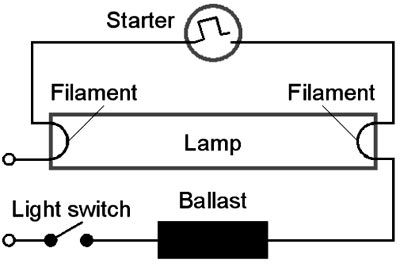In fluorescent tubes, ballast resistance is connected in series with the choke
Right Answer is:
When tube operates on dc supply
SOLUTION
The fluorescent lamp is essentially a gas discharge tube. A voltage is applied between two electrodes of a tube containing gas. Once the voltage exceeds the critical voltage, ionization voltage, gas is ionized and the ionized gas emits radiation, partly in the visible range and partly in the ultraviolet or infrared range.
Like all arc discharge lamps, the fluorescent lamp requires a ballast in its circuit. It consists essentially of an iron core on which is wound a coil. Its primary function is to limit the current in the arc circuit. For this reason, simple ballasts are referred to as chokes, since they are no more than a choke coil. Without the ballast in the circuit, the lamp would draw excessive current, and the fuse or circuit breaker would open.
Fluorescent Lighting with Electronic Ballasts—
Fluorescent lamps can run directly from a d.c. supply of sufficient voltage to strike an arc. A choke has very low impedance with dc. supply. Hence, resistance in series with the choke must be used. This would consume about as much power as the lamp. When operated from d.c. supply, the starting switch is often arranged to reverse the polarity of the supply to the lamp each time it is started; otherwise, the mercury accumulates at one end of the tube. Fluorescent lamps are (almost) never operated directly from d. c. supply for those reasons. Instead, an inverter converts the d.c. into a.c. and provides the current-limiting function as described below for electronic ballast. Its primal function is to limit the current in the arc circuit. Without the ballast in the circuit, the lamp would draw excessive current, and the fuse or circuit breaker can be open.

The efficiency of fluorescent ballasts can be improved beyond the use of energy-efficient magnetic ballasts. When fluorescent lamps are operated by an electronic ballast at high frequency, they convert the input power to light output more efficiently. The lumens per watt (LPW) of the lamp/electronic ballast combination is increased, which means either producing more light for the same power or producing the same light with lower power.
